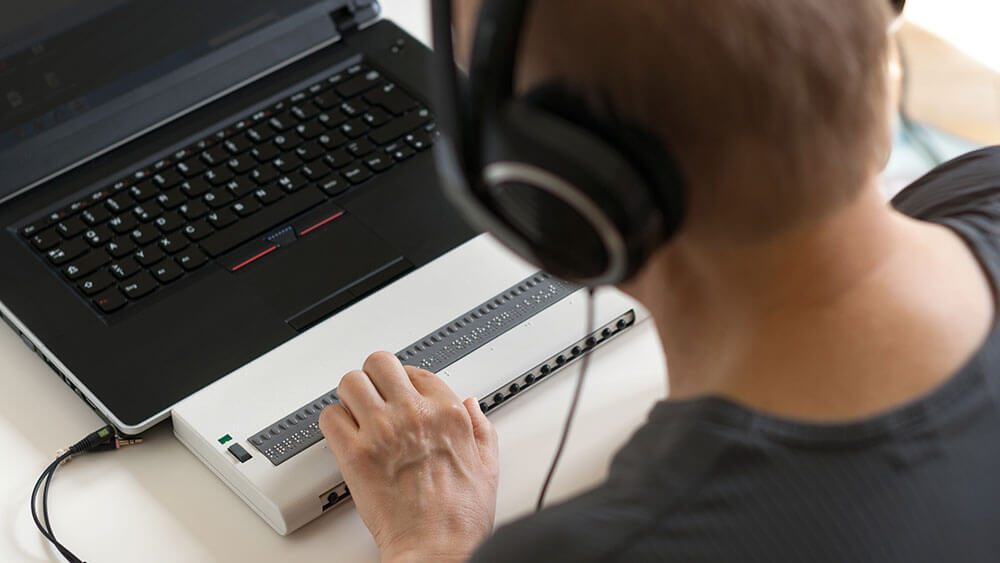
Proper equipment like a sight-challenged keyboard allows people with disabilities to work effectively from home.
Consecutive sessions are scheduled at opposite ends of the corridor. The music is blaring during the dimly lit reception, which only has bar-height tables available. The shuttle between the hotel and convention center parks a block away from the entrance to either location. None of these things pose significant issues, or even much thought, for able-bodied attendees. But for attendees with disabilities, these seemingly small factors can make navigating in-person events challenging and exhausting.
While I haven’t seen research about how virtual or hybrid meetings can positively affect the experience for attendees with disabilities, as a frequent meeting-goer who happens to have a disability, I can say access to events has become much easier for me. But since shutdowns began in mid-March and remote work became the norm for much of the workforce, a conversation surrounding the accessibility of remote work — something that shares many similarities of physically attending days-long meetings — has started taking shape.
“For people whose disabilities make commuting difficult, getting into the office can feel like its own day of work,” an article on AngelList, a startup community website, noted. “Remote work is more than just a perk for high-performing teams. It’s fundamental to making work accessible.” Before COVID-19 entered the picture, many individuals with disabilities struggled to receive reasonable accommodations to work from home, despite the fact that it removed unnecessary daily hurdles like getting ready in the morning, commuting to the office, and remaining there for an eight-hour window. In a MarketWatch article published in May, freelance writer and accessibility consultant Robert Kingett, who is blind and has cerebral palsy, said he used to struggle to find fully remote jobs, despite his type of work being easy to accomplish from home. “I really didn’t understand why,” he told MarketWatch. “I thought, do I really have to sit in an office to open up email attachments?”
A recent Forbes article cited a Brookings Institute poll that only 40 percent of U.S. adults with disabilities between the ages of 25 and 54 have a job, compared to 79 percent of all prime-working-age adults. Remote work gives individuals with special needs the freedom to work in a way that suits them, something that the constraints of an office — or in the case of meetings, a convention center — doesn’t always allow.
“For example, you have the flexibility to work when you’re not experiencing pain or sensory overload. Working from home also allows employees the flexibility to schedule doctor or physiotherapy appointments without disrupting their work,” Forbes reported.
With the sudden jump to remote work due to COVID-19, employers learned that telecommuting can work. Some organizations, like Twitter, told employees they don’t ever need to return to the office if they choose not to. Similarly, the unexpected and rapid jump to virtual meetings has proven to many event professionals whom Convene has interviewed over the last few months that virtual meetings are not always a lesser version of an in-person event, and often allow even more individuals than those who come to physical events to attend the digital event sessions and networking receptions.
In a post-COVID-19 world, many will be excited to get back to in-person events. But in the industry’s excitement to return to normal, it is important to remember that “normal” isn’t the same for everyone — and giving people the option to participate from home or in person is a wise strategy.
This story is part of Convene‘s September CMP Series package on ways the world has changed since COVID-19 and what we hope will stick once the pandemic is behind us.
Making Virtual Accommodations
Accessibility concerns are not limited to live events. Virtual meetings come with their own set of accessibility considerations that may require event planners to make adjustments for certain attendees. That’s why the University of Washington’s Alliance for Access to Computing Careers, which helps students with disabilities pursue degrees in computing fields, suggests considering universal design when creating a virtual event — proactively planning for a diverse audience instead of reactively creating makeshift accommodations when audience members have special needs.
An article published by the Alliance for Access to Computing Careers provides tips for planners to apply the principles of universal design in their virtual meeting by anticipating attendees’ needs in advance. Below are some of the key takeaways.
- Let attendees know in promotional materials that they can request disability-related accommodations for a meeting. Planners should be prepared to receive requests and know how to respond — individuals may need presentation materials in alternate formats, sign language interpreters, and more.
- Get familiar with accessibility features in virtual meeting software ahead of the event. This way, event organizers can share any necessary instructions on how to access accommodations — such as video of a sign language interpreter — before the event begins, to avoid unnecessary hiccups during the event. If an attendee is assigned a sign language interpreter or provided with captions during the event, planners should make sure that this assistance follows them throughout the event into different virtual breakout rooms and sessions.
- Provide materials ahead of time to sign language interpreters and, if the captions are being written manually, to the professional captionist. “Include names of presenters, key acronyms commonly used by your group, and an agenda,” the article suggests, to ensure individuals using these accommodations won’t miss out on any key information.
- Make sure presenters discuss key content that is presented visually. With this approach, attendees who can only join the meeting by phone or who have visual impairments will still understand the information that was presented visually.
- Follow up. After the event, event planners should provide important links, resources, and action items discussed during the event.
Learn more about the principles of universal design in presentations from the University of Washington.
Casey Gale is associate editor at Convene.
